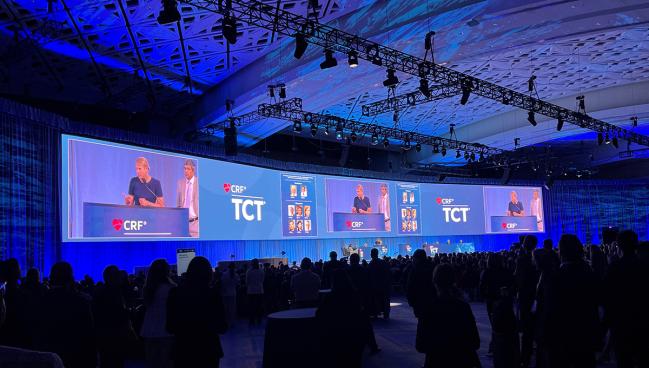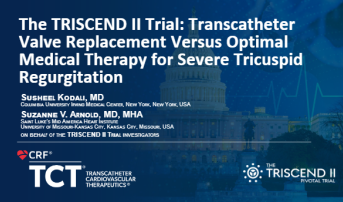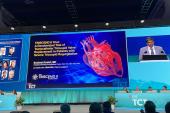TRISCEND II: Full Results a Win for TTVR in Severe Tricuspid Regurgitation
The benefit was confined to symptoms, but in a very sick population with few options, that’s important, say researchers.

WASHINGTON, DC—An update to the TRISCEND II randomized, controlled trial of transcatheter tricuspid valve replacement (TTVR) continues to highlight the positive effects of treatment in patients with symptomatic, severe tricuspid regurgitation (TR).
For the hierarchical primary outcome, the win ratio favored TTVR using the Evoque device (Edwards Lifesciences; 2.02; 95% CI 1.56-2.62), with investigators reporting marked improvements in symptoms, function, and quality of life at 1 year, as well as numerically fewer deaths from all causes and hospitalizations for heart failure (HF), when compared with optimal medical therapy (OMT), which was mainly diuretics.
Susheel Kodali, MD (NewYork-Presbyterian/Columbia University Irving Medical Center, New York, NY), who presented the results during the late-breaking clinical trials session at TCT 2024, emphasized that they were able to show the “near elimination of TR, which was sustained out to 1 year.”
The 30-day and 6-month results in the first 150 patients were previously published, and reported by TCTMD, and these early data were used by the US Food and Drug Administration to approve the Evoque TTVR system early this year. It was approved in Europe in late 2023.
Suzanne Arnold, MD (Saint Luke’s Mid America Heart Institute/University of Missouri-Kansas City), who presented the quality-of-life data, said that despite the absence of a sham control, investigators believe the gains are real.
“Sham controls are always optimal when you're talking about a patient-reported outcome in an open-label trial, but a couple of things here are reassuring,” she told TCTMD. “We did see a benefit in terms of the 6-minute walk distance and we saw trends in other outcomes. But, I think, we've done a lot of work to try to understand how much of this is biologically mediated and how much of this may be placebo effect.”
For one, the change in the Kansas City Cardiomyopathy Questionnaire overall score (KCCQ-OS) after TTVR was substantial.
“I think that helps,” said Arnold. “I think the duration of improvement that is stable for 1 year also helps. The other thing that's interesting here is that we see this continued improvement between 1 and 6 months. If this were all placebo, you would expect [the quality of life improvement] to just be all up front.”
Clyde Yancy, MD (Northwestern University Feinberg School of Medicine, Chicago, IL), who spoke with the media during a morning press conference, acknowledged the absence of a sham control, but said “we have to be very careful suggesting the exact same bar is the right approach for right-sided interventions versus left-sided interventions.”
“As a bedside clinician still taking care of patients with this condition, what they want most is to feel better,” he continued. “In the absence of this intervention, it’s a really awkward daily titration of high-dose diuretic therapy, which really doesn’t help anybody’s quality of life.”
TRISCEND II was published in the New England Journal of Medicine to coincide with the late-breaking presentation, while the quality-of-life analysis was published in the Journal of the American College of Cardiology.
What to Make of All-Cause Mortality?
In the full TRISCEND II dataset, which was conducted at 45 international sites, investigators randomized 267 patients to TTVR and 133 to OMT. Roughly 70% of patients had NYHA class III/IV symptoms and more than 92% had atrial fibrillation. In both the TTVR and OMT arms, 29.7% and 36.8% of patients had torrential TR at baseline, respectively, and 23.2% and 25.6% had massive TR, respectively.
There was a higher risk of early events with TTVR compared with OMT. Cardiovascular mortality was 3.1% within 30 days in those treated with Evoque compared with no deaths in the OMT arm. Severe bleeding occurred in 10.4% of TTVR-treated patients, and 24.7% required a new pacemaker/CIED (rates were 1.5% and zero in the OMT arm, respectively).
The hierarchical endpoint included all-cause mortality, right ventricular assist device or heart transplant, tricuspid valve intervention, heart failure hospitalization, KCCQ-OS improvement of 10 or more points, NYHA improvement of 1 or more class, and 6-minute walk distance improvement of 30 or more meters.
The overall benefits of TTVR for the primary endpoint were evident in all subgroups. All-cause mortality occurred in 12.6% of patients treated with TTVR compared with 15.2% of those in the OMT arm. In a landmark analysis from 1 month onward, all-cause mortality rates were 9.4% and 15.2% in the two study arms, respectively. Adjudicated hospitalizations for HF at 1 year occurred in 20.9% of TTVR-treated patients and 26.1% of the control group.
Regarding all-cause mortality, Kodali said there’s an early safety signal, but that the landmark analysis suggests the event curves are “starting to separate a little at 8 months.” Even the hospitalizations for HF appear to separate in favor on TTVR at that time point, but investigators say they can’t make any definitive statements about these observations.
To TCTMD, Arnold said that because Evoque is now commercially available and patients will begin crossing over from OMT to TTVR, it will be impossible to study these patients further to truly determine if there’s a mortality benefit or reduction in hospitalizations. Those that don’t crossover to receive TTVR, “are probably doing OK so it really biases the analysis,” she said. “Unfortunately, it’s one of those questions that we won’t have answered.”
Azeem Latib, MD (Montefiore-Einstein Center for Heart and Vascular Care, Bronx, NY), however, urged investigators to avoid allowing patients to crossover to TTVR until beyond 2 years. With TTVR, given the up-front risks of treatment, it will be worthwhile to learn if mortality is lower in longer follow-up. “I’m an investigator, too, and my plea to other investigators is we need to sit tight,” he told TCTMD. “One thing that's good that we see from this study is that we're not harming patients or increasing [the risk of] death by waiting.”
Quality of Life Improvements
The quality-of-life analysis included 392 patients, of whom 259 underwent TTVR. At baseline, health status was substantially impaired, said Arnold, noting that the baseline KCCQ-OS was 52.1 (KCCQ scored 0 to 100, with higher scores equaling better quality of life).
At 30 days, the mean between-group difference in the KCCQ-OS was 11.8 points favoring TTVR, 20.8 points at 6 months, and 17.8 points at 1 year. Within the KCCQ, quality of life and social domains had the largest gains with TTVR.
Integrating health status with the KCCQ-OS, 57.6% of patients treated with TTVR were alive with moderate improvements in the KCCQ at 1 year, 39.5% were alive with large improvements, and 64.6% were alive and well. In the control arm, the respective numbers were 31.0%, 19.5%, and 31.0%. In terms of changes to health status, 58% of the Evoque-treated patients reported large or moderate changes at 1 year compared with 31% in the control group.
While the KCCQ is a HF-specific health status tool originally developed for use in patients with reduced left ventricular ejection fraction, Arnold evaluated its psychometric properties in roughly 2,700 patients with TR undergoing a transcatheter tricuspid valve intervention. Known as the Tri-QOL study, and published today in JAMA Cardiology, Arnold said they found that dyspnea and fatigue are by far the most important symptoms to these patients.
“It’s what most impacts their quality of life and their function,” she said. “Congestive symptoms, while present, are really there in a minority of patients and never in isolation.” Their new study, she added, “made us feel very comfortable that the KCCQ is capturing at least the vast majority of quality of life in these patients.”
Reproducible and Teachable Procedure
Earlier at TCT, the TRILUMINATE investigators presented more data on patients with symptomatic severe TR treated with transcatheter edge-to-edge repair (TEER). Like TRISCEND II, the benefit of treatment was largely driven by quality of life, although there was also an improvement in 6-minute walk distance and a suggestion of benefit on HF hospitalizations.
To TCTMD, Latib said the US operators now have two devices—TTVR with Evoque and TEER with TriClip (Abbott)— to make patients with severe TR feel better. “I think this data will help physicians in making informed decisions with their patients about which device is best for them,” he said.
In TRILUMINATE, cardiovascular mortality at 30 days was just 0.4%, major bleeding was 3.2%, and there was no risk of needing a new pacemaker. TTVR, said Latib, will likely make patients feel better because it nearly eliminates TR entirely, but there’s an up-front cost to treatment.
“I think what's going to happen in each center is that physicians are going to use these findings to try and create their own algorithms for what to offer a patient, if they can undergo both procedures,” said Latib. “I think if you can offer them both, many physicians may elect to go for the safer device, and potentially, Evoque may be the therapy they look at for the patient who can't get the low-risk device.”
Latib said there’s also a number of unknowns right now, noting that surgeons fret about right-sided valves given concerns about device durability. There’s also not much known about risks of valve thrombosis, which will be higher on the right side because of the low-flow state.
Neil Fam, MD (University of Toronto/St. Michael’s Hospital, Canada), who performed the first-in-human TTVR 5 years ago, called TRISCEND II a “home run” for patients suffering from symptomatic severe TR. He also highlighted the up-front risks of bleeding and need for a new pacemaker, which will need to be balanced with the clinical benefits for individual patients via shared decision-making.
“This is a very reproducible, teachable procedure for heart teams,” he said. “And the rapid enrollment in this trial reflects the unmet clinical need. These patients didn’t have any other options.”
To TCTMD, Kodali said the choice between TEER and TTVR comes down to physician preference and patient anatomy. The imaging requirements for replacement are less, he said, but there are technical limitations with TEER in patients with large coaptation gaps or those with a very dilated annulus, for example, where are TTVR is the only option.
“But I think there’s a big cohort in the middle where you can do both,” he said. “In that big cohort, it really depends on operator expertise and physician preference.”
Michael O’Riordan is the Managing Editor for TCTMD. He completed his undergraduate degrees at Queen’s University in Kingston, ON, and…
Read Full BioSources
Hahn RT, Makkar R, Thourani VH, et al. Transcatheter valve replacement in severe tricuspid regurgitation. N Engl J Med. 2024;Epub ahead of print.
Arnold SV, Hahn RT, Thourani VH, et al. Quality of life after transcatheter tricuspid valve replacement: 1-year results from TRISCEND II pivotal trial. J Am Coll Cardiol. 2024;Epub ahead of print.
Arnold SV, Spertus JA, Gosch K, et al. Validation of the Kansas City Cardiomyopathy Questionnaire in patients with tricuspid regurgitation. JAMA Cardiology 2024;Epub ahead of print.
Disclosures
- Kodali reports grant/research support from Edwards Lifesciences, Medtronic, Boston Scientific, Abbott Vascular, and JenaValve; consulting fees from Anteris, Dura Biotech, Shifamed, Tricares, Philips, Nyra Medical, Helix Valve Repair, X-Dot, Microinterventional Devices, Moray Medical, Supira, Adona, and Tioga; and holds stock/options in Thubrikar Aortic Valve, Dura Biotech, Supira, MID, TriFlo, Adona, Tioga, Moray Medical, and Cardiomech.
- Arnold reports no relevant conflicts of interest.
- Fam reports consulting fees/honoraria from Edwards Lifesciences, Abbott, Venus Medtech, and Medtronic.







Comments